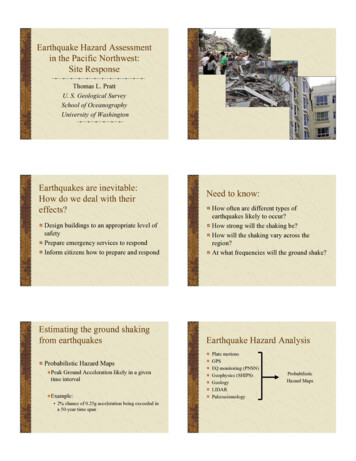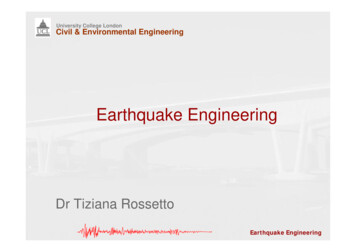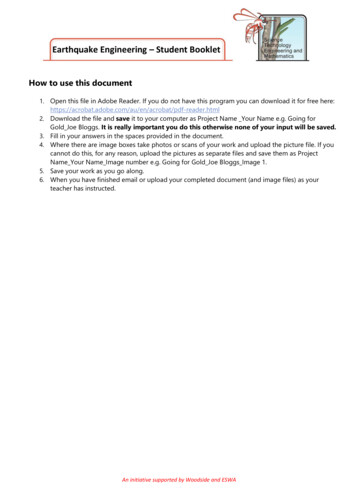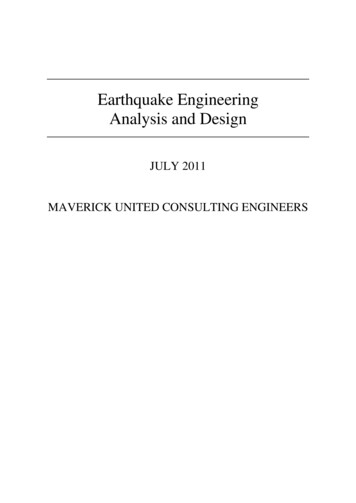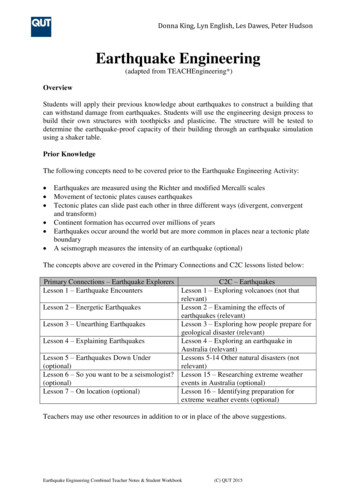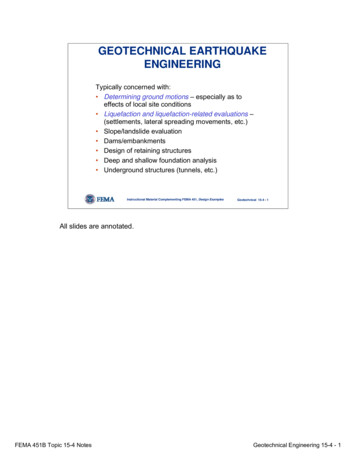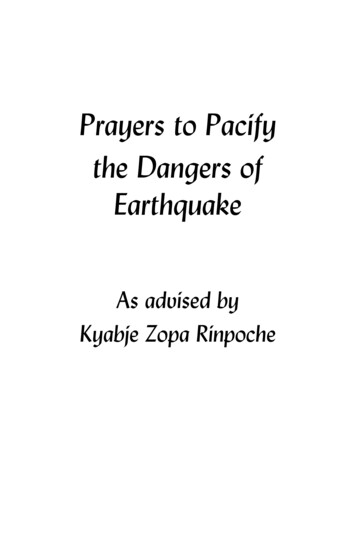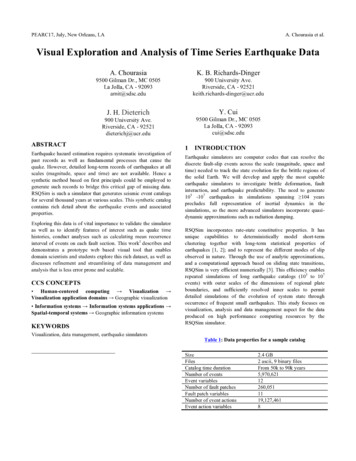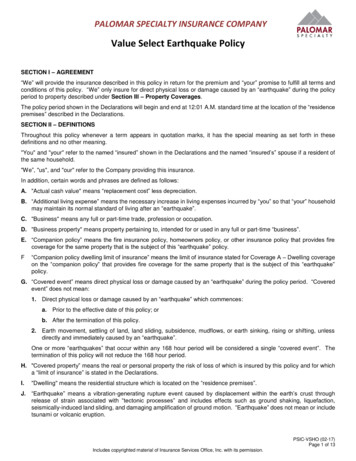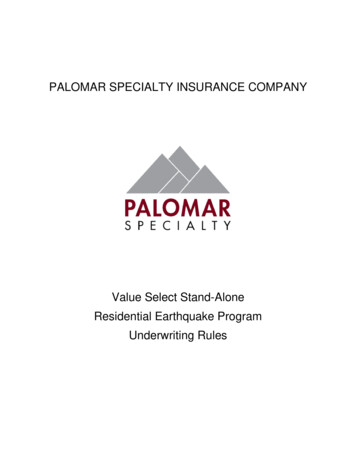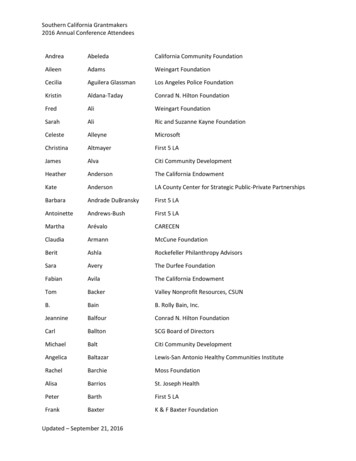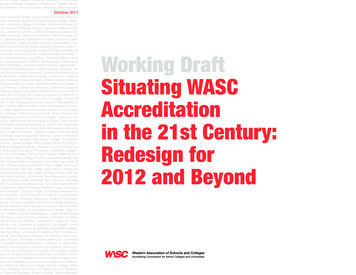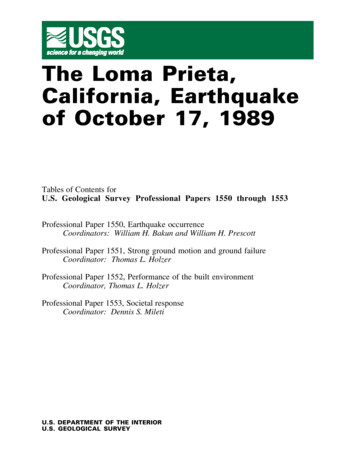
Transcription
The Loma Prieta,California, Earthquakeof October 17, 1989Tables of Contents forU.S. Geological Survey Professional Papers 1550 through 1553Professional Paper 1550, Earthquake occurrenceCoordinators: William H. Bakun and William H. PrescottProfessional Paper 1551, Strong ground motion and ground failureCoordinator: Thomas L. HolzerProfessional Paper 1552, Performance of the built environmentCoordinator, Thomas L. HolzerProfessional Paper 1553, Societal responseCoordinator: Dennis S. MiletiU.S. DEPARTMENT OF THE INTERIORU.S. GEOLOGICAL SURVEY
ContentsProfessional Paper 1550-AThe Loma Prieta, California, Earthquake ofOctober 17, 1989—Main Shock CharacteristicsPaul Spudich, Editor---------PageSynopsisby Paul Spudich.A1Rupture history of the earthquake from high-frequency strong-motion databy Gregory C. Beroza.9Source characteristics of the earthquake from global digital seismic databy George L. Choy and John Boatwright . 33Comparison of L 1 and L2 norms in a teleseismic-waveform inversion forthe rupture history of the earthquakeby Stephen H. Hartzell, Gordon S. Stewart, and Carlos Mendoza. 39Frequency-domain inversion for the rupture characteristics during theearthquake, using strong-motion data and geodetic observationsby Stephen Horton, John G. Anderson, and Andres J. Mendez. 59Broadband study of the source characteristics of the earthquakeby Hiroo Kanamori and Kenji Satake . 75Geodetic measurements of coseismic horizontal deformationby Michael Lisowski, Mark H. Murray, and Jerry L. Svarc . 81Elevation changes associated with the earthquake and their use to inferfault-slip geometryby Grant A. Marshall and Ross S. Stein.105Main-shock and very early aftershock activityby Karen C. McNally, Gerald W. Simila, and Judy G. Brown .147Downdip geometry of the Loma Prieta rupture from teleseismicwaveform inversionby John L. Náb lek .171Mechanical modeling of fault-fold system, with application to the earthquakeby Ze’ev Reches and Mark D. Zoback. .183Are rupture models consistent with geodetic measurements?by Jamison H. Steidl and Ralph J. Archuleta .195Long-period surface-wave observations of the earthquakeby Aaron A. Velasco, Thorne Lay, and Jiajun Zhang.209Source parameters of the earthquake, determined by using long-periodseismic wavesby Aaron A. Velasco, Thorne Lay, and Jiajun Zhang.215
Strong-motion and broadband teleseismic analysis of the earthquake forrupture-process modeling and hazard assessmentby David J. Wald, Donald V. Helmberger, and Thomas H. Heaton . 235Coseismic displacements measured with the Global Positioning Systemby Chesley R. Williams and Paul Segall . 263Estimation of the rupture velocity of the main shock from the Love-wavegroup velocityby Francis T. Wu . 279Use of stress-drop models to interpret Geodelite/Global Positioning Systemand leveling measurements at Loma Prietaby Mingdong Wu and John W. Rudnicki. 289
ContentsProfessional Paper 1550-BThe Loma Prieta, California, Earthquake ofOctober 17, 1989—ForecastsRuth A. Harris, Editor–––––PagePreface. IIIAbstract. B1Introduction. B1The forecasts. B5Reid. B5Willis. B6Tocher. B6Thenhaus and others. B7Ellsworth and others. B7U.S. Geological Survey. B7Moths and others. B7Lindh and others. B8Sykes and Nishenko. B9Scholz. B10Keilis-Borok and others. B10Thatcher and Lisowski. B11Wesson and Nicholson. B13Working Group on California Earthquake Probabilities. B15Davis (Lake Elsman earthquakes). B17Kerr. B17The 1989 Loma Prieta earthquake. B18Comparison of the forecasts with the 1989 Loma Prieta earthquake. B19Post-Loma Prieta information that might have led to differentforecasts. B191906 slip models—geologic information. B201906 slip models—geodetic information. B21San Andreas fault-slip-rate measurements. B21Was the 1989 Loma Prieta earthquake an anticipated event?. B21Summary. B22Acknowledgments. B22References cited. B23Appendixes:1. Definition of an earthquake advisory. B252. The Lake Elsman advisory. B253. Peck and Pearlman correspondences. B26
ContentsProfessional Paper 1550- CThe Loma Prieta, California, Earthquake ofOctober 17, 1989—Preseismic ObservationsMalcolm J.S. Johnston, Editor---------PageIntroductionby Malcolm J.S. Johnston.C1Seismicity in the southern Santa Cruz Mountains during the 20-yearperiod before the earthquakeby Jean A. Olson and David P. Hill .3Analysis of low-frequency-electromagnetic-field measurements near theepicenterby Anthony C. Fraser-Smith, Arman Bernardi, Robert A.Helliwell, Paul R. McGill, and O.G. Villard, Jr. 17Seismomagnetic effectsby Robert J. Mueller and Malcolm J.S. Johnston . 27Near-source short- to intermediate-period ground motionsby Randall A. White and William L. Ellsworth . 31A reported streamflow increaseby Evelyn Roeloffs . 47Near-field high-resolution strain measurementsby Malcolm J.S. Johnston and Alan T. Linde. 53A shear-strain precursorby Michael T. Gladwin, Ross L. Gwyther, and Rhodes H.G. Hart . 59No convincing precursory geodetic anomaly observedby Michael Lisowski, James C. Savage, William H. Prescott,Jerry L. Svarc, and Mark H. Murray. 67Detection of hydrothermal precursors to large northern California earthquakesby Paul G. Silver, Natalie J. Valette-Silver, and Olga Kolbek. 73Borehole strain measurements of solid-earth-tidal amplitudesby Alan T. Linde, Michael T. Gladwin, and Malcolm J.S. Johnston . 81
ContentsProfessional Paper 1550- DThe Loma Prieta, California, Earthquake ofOctober 17, 1989—Aftershocks and Postseismic EffectsPaul A. Reasenberg, Editor---------PageIntroductionby Paul A. Reasenberg.D1Aftershocks of the Loma Prieta earthquake and their tectonic implicationsby Lynn D. Dietz and William L. Ellsworth.5Response of regional seismicity to the static stress change produced bythe Loma Prieta earthquakeby Paul A. Reasenberg and Robert W. Simpson . 49Spatial variations in stress from the first six weeks of aftershocks of theLoma Prieta earthquakeBy John W. Gephart . 73Loma Prieta aftershock relocation with S-P travel times from a portable arrayby Susan Y. Schwartz and Glenn D. Nelson. 91Empirical Green’s function study of Loma Prieta aftershocks: determinationof stress dropby H. Guo, A. Lerner-Lam, W. Menke, and S.E. Hough .105U.S. Geological Survey aftershock ground-motion databy Leif Wennerberg .121Response of U.S. Geological Survey creepmeters to the Loma Prietaearthquakeby K. S. Breckenridge and R.W. Simpson .143Increased surface creep rates on the San Andreas fault southeast of theLoma Prieta main shockby Jeff Behr, Roger Bilham, Paul Bodin, Kate Breckenridge,and Arthur G. Sylvester.179Effect of the Loma Prieta earthquake on fault creep rates in the San FranciscoBay regionby Jon S. Galehouse. .193Postseismic strain following the Loma Prieta earthquake fromrepeated GPS measurementsby Roland Bürgmann, Paul Segall, Mike Lisowski, andJerry L. Svarc .209Shallow, postseismic slip on the San Andreas fault at the northwestern endof the Loma Prieta earthquake rupture zoneby John Langbein. .245
Models of postseismic deformation and stress transfer associated with theLoma Prieta earthquakeby M.F. Linker and J.R. Rice.253A shear strain anomaly following the Loma Prieta earthquakeby M.T. Gladwin, R.L. Gwyther, and R.H.G. Hart .277A magnetotelluric survey of the Loma Prieta earthquake area: implications forearthquake processes and lower crustal conductivityby Randall L. Mackie, Theodore R. Madden, and Edward A.Nichols.289
ContentsProfessional Paper 1550 - FThe Loma Prieta, California, Earthquake ofOctober 17, 1989—Tectonic Processes and ModelsRobert W. Simpson, Editor---------PageIntroductionby Robert W. Simpson. F1Relations between folding and faulting in the Loma Prieta epicentralzone: Strike-slip fault-bend foldingby John H. Shaw, Richard E. Bischke, and John Suppe.3Geologic assessment of the relative contribution of strike-slip faulting,reverse-slip faulting, and bulk squeezing in the creation of thecentral Santa Cruz Mountains, Californiaby Gianluca Valensise. 23Complex fault interactions in a restraining bend on the San Andreas fault,southern Santa Cruz Mountains, Californiaby Susan Y. Schwartz, Daniel L. Orange, and Robert S.Anderson. 49Earthquake-induced static-stress changes on central California faultsby Robert W. Simpson and Paul A. Reasenberg . 55Cumulative slip along the peninsular section of the San Andreas fault, California,estimated from two-dimensional boundary-element models of historicalruptureby Paul Bodin and Roger Bilham. 91Three-dimensional lithospheric kinematics in the Loma Prieta region,California: Implications for the earthquake cycleby Kevin P. Furlong and David Verdonck .103
ContentsProfessional Paper 1551- AThe Loma Prieta, California, Earthquake ofOctober 17, 1989—Strong Ground MotionRoger D. Borcherdt, Editor---------PageSynopsisby Roger D. Borcherdt.A1Strong-motion recordingsby A. Gerald Brady and Anthony F. Shakal .9Effect of known three-dimensional crustal structure on the strong groundmotion and estimated slip history of the earthquakeby Vernon F. Cormier and Wei-Jou Su. 39Simulation of strong ground motionby Jeffry L. Stevens and Steven M. Day . 53Influence of near-surface geology on the direction of ground motionabove a frequency of 1 Hzby John E. Vidale and Ornella Bonamassa . 61Effect of critical reflections from the Moho on the attenuation of strongground motionby Paul G. Somerville, Nancy F. Smith, and Robert W.Graves67 geology on strong and weak ground motionsInfluencesof localrecorded in the San Francisco Bay region and their implicationsfor site-specific building-code provisionsby Roger D. Borcherdt and Gary Glassmoyer . 77Ground response on Treasure Islandby Kyle M. Rollins, Michael D. Mchood, Roman D. Hryciw,Matthew Homolka, and Scott E. Shewbridge.109Ground-response studies at the Alameda Naval Air Stationby Harvey Carlisle and Kyle M. Rollins.123Behavior of young bay mud from the Marina District of San Franciscounder static and cyclic simple shearby Nicholas Sitar and Rodrigo Salgado.145Deep instrumentation array at the Treasure Island Naval Air Stationby Pedro de Alba, Jean Benoît, Daniel G. Pass, John J. Carter,T. Leslie Youd, and Anthony F. Shakal .155Site response in Oakland, California, near the failed section ofthe Nimitz Freewayby E.H. Field, Susan E. Hough, Klaus H. Jacob, andPaul A. Friberg. 169
Aftershock observations from a dense array in Sunnyvale,Californiaby Arthur Frankel, Susan E. Hough, Paul Friberg, andRobert Busby. 181A three-dimensional simulation of seismic waves in the Santa ClaraValley, California, from an aftershockby Arthur Frankel and John E. Vidale. 197Site-response models from high-resolution seismic reflection andrefraction data recorded in Santa Cruz, Californiaby Robert A. Williams, Edward Cranswick, and KennethW. King. 217Variation of seismic site effects in the Santa Cruz Mountains,Californiaby Grant T. Lindley and Ralph J. Archuleta. 243A post-earthquake reevaluation of seismic hazard in the SanFrancisco Bay regionby Janice M. Murphy and Steven G. Wesnousky . 255
ContentsProfessional Paper 1551- BThe Loma Prieta, California, Earthquake of October 17,1989—LiquefactionThomas L. Holzer, Editor---------PageIntroductionby Thomas L. Holzer.B1Liquefaction characteristics of San Francisco bayshore fillsby Jean Lou A. Chameau, G. Wayne Clough, J. David Frost,and Fernando A.M. Reyna .9Soil liquefaction in the east bay during the earthquakeby Robert E. Kayen, James K. Mitchell, Raymond B. Seed, andShin'ya Nishio . 61Analysis of liquefaction-induced damage on Treasure Islandby Maurice S. Power, John A. Egan, Scott E. Shewbridge,John deBecker, and J. Richard Faris. 87Sand boils and settlement on Treasure Island after the earthquakeby Michael J. Bennett .121Liquefaction at Moss Landingby Lelio H. Mejia .129Observations of multiple liquefaction events at Soda Lake,California, during the earthquake and its aftershocksby John D. Sims and Cristofer D. Garvin .151Postearthquake investigations at liquefaction sites in Santa Cruzand on Treasure Islandby Roman D. Hryciw, Scott E. Shewbridge, Alan Kropp, andMatthew Homolka .165Direct measurement of liquefaction potential in soils ofMonterey County, Californiaby Wayne A. Charlie, Donald O. Doehring, Jeffrey P. Brislawn,and Hassen Hassen.181Comparison of computed and measured liquefaction-inducedsettlements in the Marina District, San Francisco, Californiaby Kyle M. Rollins and Michael D. McHood .223Improved-ground performance during the earthquakeby James K. Mitchell and Frederick J. Wentz, Jr.241Evaluation of liquefaction hazard mapping in the MontereyBay Area, Central Californiaby William R. Dupré and John C. Tinsley, III.273Appendix: Maps and descriptions of liquefaction and associated effects
by John C. Tinsley, III, John A. Egan, Robert E. Kayen,Michael J. Bennett, Alan Kropp, and Thomas L. Holzer.287Plates1.Locations of ground failure features and distress to facilities on Treasure Islandfrom the earthquake.2.Liquefaction and associated effects in the San Francisco Bay area from theearthquake.3.Liquefaction and associated effe
Robert Busby. 181 A three-dimensional simulation of seismic waves in the Santa Clara Valley, California, from an aftershock by Arthur Frankel and John E. Vidale. 197 Site-response models from high-resolution seismic reflection and refraction data recorded in Santa Cruz, California by Robert
